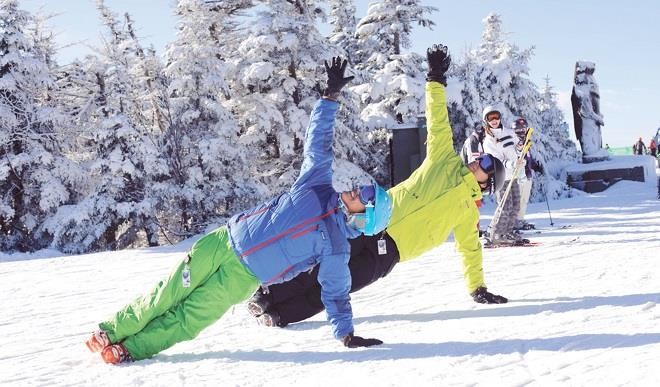
Had it not been for her bright lavender coat, I would not have recognized the 3-year-old who staggered out of the lodge and took her first tentative steps, feet weighted with ski boots, in the snow. A helmet covered her head, hot-pink goggles concealed her eyes, and a neoprene face mask adorned with a drawing of a cat nose and whiskers hid her nose and mouth.
But the coat, the one with the stubborn stain on the back, gave her away. There was my daughter, less sure-footed than I’d recalled seeing her since she’d learned to walk, and before I knew it, the tears began pooling at the bottom of my own goggles.
For the first few years of your child’s life, the physical milestones come in such rapid succession that they’re difficult to keep track of. Rolling over. Sitting up. Pulling up. Crawling. Walking. For every skier, there’s another milestone that you won’t realize you’d been waiting for until your child is heading up the gentle incline of a bunny slope: skiing.
Bringing my daughter skiing with me had been a goal of mine since she was a newborn. My own family lacked the means to go skiing – the closest we came was sledding down a giant hill in a suburb of Cleveland – and my own ability level remains permanently stuck in intermediate, but downhill skiing’s appeal for me lies not in mastering a physical challenge. It is simply the best way to be outside during the winter.
I wanted to give the girl we’d nicknamed Bean a childhood filled with memories of standing at the top of a trail, surveying the glacial mountain vistas, and then, heart leaping, schussing down a hill so confidently that she took being able to do it for granted. And, I admit, I wanted a do-over of my own entree into skiing as an adolescent in Ohio, where I mainly made it down the slopes by giving up any pretense of remaining upright and sliding down on my rear end.
It would be different for Bean, I thought, falling into the trap of every parent who tries to right a childhood wrong. I’d learned the hard way, with little guidance and probably not enough adult intervention. (I mastered stopping only when a friend broke her leg after being leveled by a reckless skier.) I imagined that by the end of our long weekend, we’d be skiing down the bunny slopes, hand in hand, faces beaming, executing perfect wedges in unison.
We started out full of optimism at Mount Sunapee resort in New Hampshire, chosen because it was a mere five hours’ drive from New York and because it had a well-outfitted day care that also offers children as young as 3 a ski lesson. Bean spent the better part of the afternoon indoors, playing with dolls with her 4-year-old cousin, and when she finally made it outside, the gear and the bitter cold conspired to keep her off-kilter. Every step of even getting to the top of the bunny hill was excruciatingly labored. Her teacher, Rachel, a well of patience, kept urging her on in a high-pitched singsongy voice that all the instructors used, possibly to ward off any hint of a malevolent tone.
First, the boots had to be snapped into the ski bindings. Rachel broke this step, which experienced skiers do in a few seconds unthinkingly, into its component parts: “Lift your leg. Move your foot over that part. Put your boot there. Toe first. Step down. Harder. It didn’t snap? Try again!” Countless attempts later, both skis were on, and Rachel was still inexplicably chirpy.
Step 2 was to get on the magic carpet. For those who learned to ski on bunny hills serviced with tow ropes, the carpets are incredibly addictive escalator-like contraptions that grip your skis with a shocking force and propel you up a hill at a pace that someone in ski boots could probably outwalk without breaking a sweat. For beginners, riding it is the first real challenge of skiing.
If you fall off the magic carpet, Bean would learn from experience, it will stop. Instructors will rush to right you while other skiers look around for the culprit who caused the delay. It would be mortifying for an adult, but for a child? Sort of exciting. I got to witness this routine quite a few times. Amazed at the powerful grip that the carpet exerted on her skis, Bean would lift her leg, lose her balance and fall. Dismounting was just as difficult as staying on for a novice. Switching from the sticky rubber to the slippery snow is tricky, and from the bottom of the modest hill, I spied my daughter’s lavender coat as she flopped to the ground.
But then, all of a sudden, she was ready to ski down. Stick straight, she glided, holding Rachel’s hand. Next go ‘round, Rachel got Bean to let go by singing, “If you’re happy and you know it, clap your hands.” She sailed with ease down the hill. “Olympics 2030, that’s where she’ll end up,” I thought, slipping into a fantasy of a network camera cutting to me after she’d won a medal in an Alpine skiing event. I forced myself to snap back to reality. It was, after all, supposed to be about nature and the mountains and all that pretty winter stuff.
“Were you scared?” I later asked her about her first few runs. “Afraid?” she asked. “Why? There’s no monster there.”
When we returned to the mountain the next day, everything had changed. It was a sunny Saturday, and the temperature had risen from the teens to the balmy mid-20s. My daughter and her cousin watched “Frozen” at the day care, and primed for the snow, they set out for the hill, visions of Elsa in their heads. This time, Bean had no face mask, and I could see her smile when she recognized me lingering outside the gate at the bottom of the hill.
Rachel, the instructor, must have had the day off. She was replaced by a skinnier, teenage girl who did not speak in an excessively cheerful voice but nonetheless seemed happier than I would have been about skiing with a bunch of young children. Bean’s muscle memory from the day before had already taken hold. There would be no spills from the magic carpet that day. She and her cousin rode up and skied down effortlessly, and soon enough, a clutch of relatives gathered at the bottom of the hill, applauding their every move.
The teacher began trying something different now, encouraging the children to lean over to touch nylon sticks tethered to the ground as they glided down the hill, things that she called “whiskers.” In the end, whatever she was hoping to accomplish with those whiskers didn’t take. When the family brought out an iPad to record the girls, they decided to focus on mugging for their adoring public rather than skiing, and then abruptly said that they wanted to go inside and play with dolls again.
Though we had pretty much crashed the lesson, I brushed aside my guilt with the realization that this was a family ski trip, after all. Maybe the next day we could skip the lesson and simply ski together.
So we headed across the state line to Okemo in Vermont and rented Bean some skis at the same time we rented ours. The moment that I first envisioned seemed close: the two of us, gliding, hand in hand.
Up I went on the magic carpet (which, by the way, was more difficult to mount than I’d realized), and at the top of the hill, Bean waited and then took my hand. The sun was out, it was in the 30s, and it was a perfect Kodak moment.
But then something happened to my arm. It apparently was not strong enough to support the immense weight of a child struggling to keep her balance. I felt as if I were tethered to a bowling ball determined to take me down. We slid forward about 15 feet, the entire time with me frantically yelling for her to stand up, try to balance, stop moving her feet, to slow down! (It was the polar opposite of sweet Rachel’s tone.) Finally, I let out an anguished yelp, and my husband walked back up the hill and rescued us. He skied down with her a few times, and then my brother took a turn, skiing backward while she skied forward. I saw the first hint of a very narrow wedge.
Then it happened. She somehow broke away from the pack at the top of the hill. She skied down swiftly on her own, the wind rushing in her face. She didn’t yet know how to stop, though, so after a frantic race, her father caught up with her and tried to slow her down, and in the process of doing so, she took a tumble.
She got up again, laughing. Surviving the fall had emboldened her. She reminded me that beginning anything, especially skiing, means that you have to get comfortable with failure. From then on, nobody could convince Bean that she couldn’t ski, that she didn’t belong on that hill, occasionally stumbling through the snow and making it her home.
Distributed by The New York Times Syndicate

 Join Daily Trust WhatsApp Community For Quick Access To News and Happenings Around You.
Join Daily Trust WhatsApp Community For Quick Access To News and Happenings Around You.


